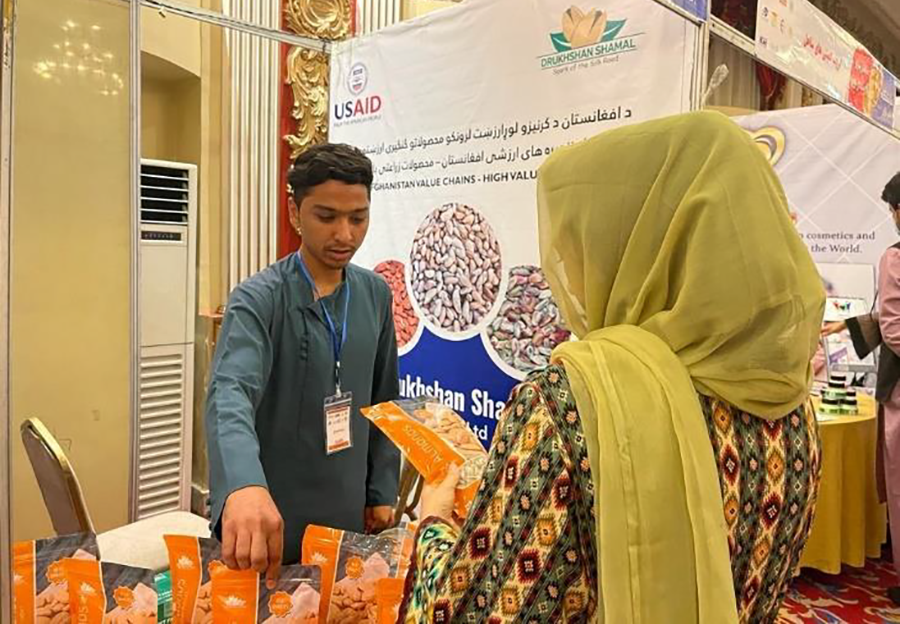Afghanistan—Value Chains-Crops (AVC)
Client: U.S. Agency for International Development
Duration: 2018-2023
Region: Eastern Europe and Central Asia
Country: Afghanistan
Solutions: Economic Growth
The Afghanistan Value Chains–Crops (AVC) project promoted rapid, inclusive, and lasting growth in the agriculture sector. This approach combined market systems development, which addresses market failures through interventions that modify market players’ incentives and behavior, with the use of anchor firms, i.e. well-established agribusinesses positioned to drive systemic change, as entry points and partners. This combined approach promoted behavior change, drove innovation, and accelerated economic growth in a way that ensures lasting and large-scale transformational market system change.
Since 2018, the project partnered with 259 agribusinesses, exported $44 million worth of high-value crops and facilitated $196 million in sales of firms and farms, $23.4 million in investment, and $17 million in agricultural loans. Despite unprecedented challenges, AVC-Crops had significant achievements in developing agricultural value chains in partnership with agribusinesses in 34 provinces of Afghanistan, touching the lives of 100,000 households.

Sample Activities
- Support anchor firms to co-create upgrading strategies, so that they can exert a pull factor that would result in the systemic growth of the value chains.
- Enable anchor firms to penetrate new markets by facilitating their participation in international trade events.
- Provide technical services, including food safety training and certifications, packaging design, and optimization of agro-processing lines.
- Facilitate access to finance, both debt and equity, establishing partnerships to reduce the cost and time of transport.
- Promote the delivery of private sector agricultural extension services.
- Give 10,000 individuals from the poorest households across Afghanistan the opportunity to participate in community work. These activities will be prioritized by community leaders and could include cleaning irrigation canals, repairing roads, preparing land for crop production, or supporting other community efforts. This emergency relief food-for-work activity will last three months, generating about 720,000 days of work and providing food for approximately 80,000 individuals.
Select Results
- Pivoted from a value chain development activity to a humanitarian assistance program, following the fall of the Afghan government in August 2021.
- Procured $10 million worth of agricultural inputs and foodstuffs, and engaged 55,000 rural households to address food insecurity.
- Assisted 55,000 rural households in the form of crop production inputs and food for work assistance.
- Produced 45,000 metric tons of wheat, 30,000 metric tons of vegetables, 11,000 metric tons of rice, and 15,000 metric tons of legumes—enough to feed 600,000 individuals for a six-month period.
- Generated 100,000 man/days of work, resulting in the rehabilitation of 1,277 kilometers of irrigation canals, 17 karezes, 147 springs, 33,389 contour trenches, and built 258 check dams.
- As part of its COVID-19 response, the project invested $77,000 to incentivize exports through new routes and transport means, resulting in 92 shipments to Canada, the United States, Australia, Germany, Saudi Arabia, and Japan worth $4.5 million (a 58:1 return on investment). These and other pre-COVID activities resulted in $6.4 million in additional investment in agriculture and $10.6 million in incremental exports.
- Sponsored the first Afghanistan National Young Innovators in Agriculture Competition.
- Established partnerships with 259 agribusinesses.
- Facilitated $196 million in sales of firms and farms.
- Assisted in the investment of $23 million.
- Enabled firms in accessing $17 million in business loans.
- Assisted 19,500 farmers (30 percent women and 35 percent young people) to access modern production and quality-enhancing technologies.
- Facilitated an 18 percent increase in household income.
- Facilitated a 24 percent increase in the production of key products.
- Trained 6,322 individuals.
- Helped create 1,075 new full-time employment jobs.
Featured Links
RELATED CONTENT:
Egypt—Technical Assistance Improving Access to Finance by Facilitating Business Expansion of Promising and Growing Small and Medium Enterprises
DAI increased access to capital and financial resources for underserved groups of small firms by working with the Bank of Alexandria in enhancing understanding of the issues specific to small firm lending, introducing the best lending and advisory practices, helping to design and roll out a programme that includes nonfinancial services aiming to improve financial literacy among final beneficiaries.
Read More